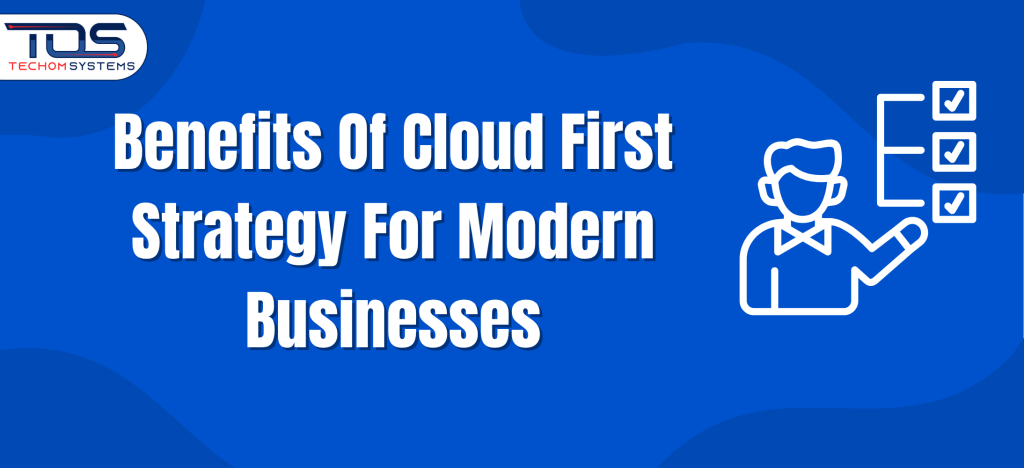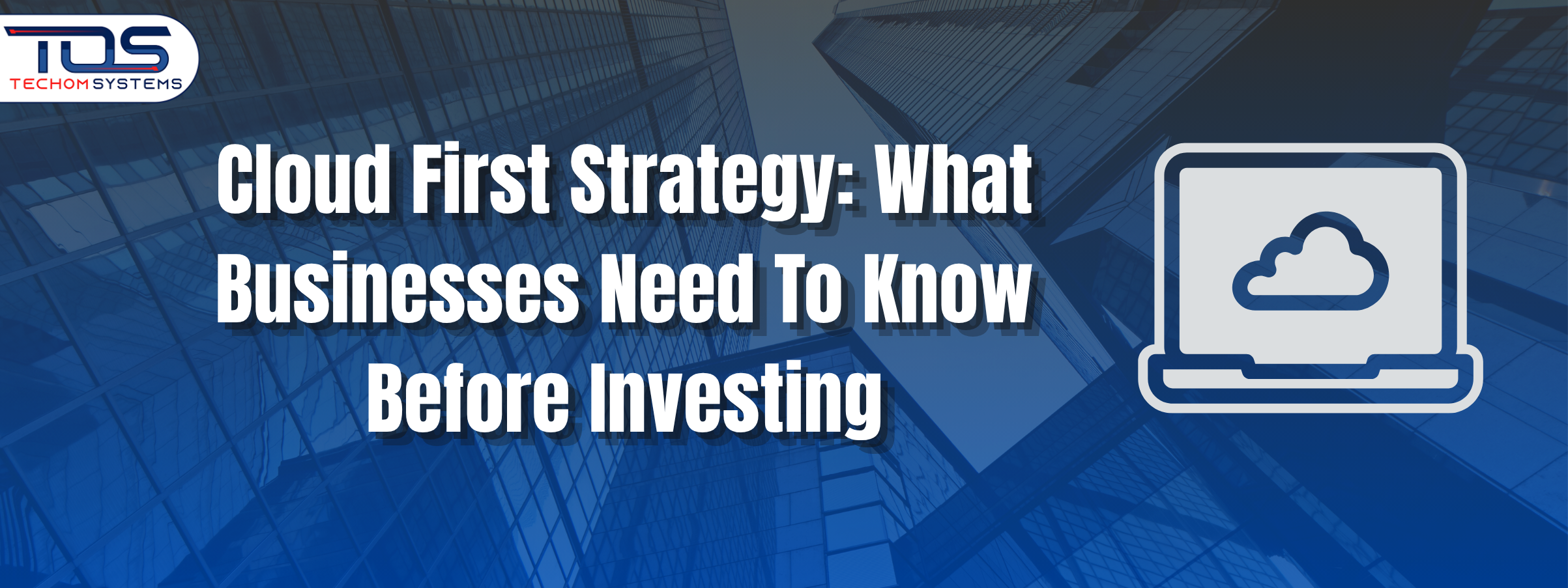In today’s fast-paced digital world, many businesses are adopting a Cloud First Strategy to stay competitive, reduce costs and improve agility. This approach places cloud based tools and platforms at the center of every IT decision.
Before making the shift, it is important to understand what a cloud first strategy involves, how it compares to traditional systems and the steps needed for a smooth transition.
In this blog, we explain the key concepts, benefits and what businesses need to know before investing. If you’re considering cloud adoption, this guide will help you make a smart and confident choice.
What Is Cloud First Strategy and Why Does It Matter?
The Cloud First Strategy is a modern way for businesses to manage their IT needs. Instead of using traditional methods like on site servers and software, this strategy encourages companies to look at cloud based solutions first.
What does it mean?
When a business follows a Cloud First Strategy, it means that:
- Every time the business needs a new application, system, or IT service, it first checks if there is a cloud based option available.
- Cloud based solutions are preferred over older on premises systems.
- It becomes a default mindset to choose cloud technology before anything else.
This approach is called the cloud first approach and it is now popular among companies that want to grow faster, work smarter and stay flexible.
Why are businesses choosing this?
Here are the main reasons why the Cloud First Strategy matters:
- It helps teams access data and apps from anywhere, which is ideal for remote work.
- It reduces the cost of buying and maintaining physical IT infrastructure.
- It allows businesses to scale up or down easily as needed.
- It improves security and allows better backup and recovery.
- It will keep the company ready for future digital changes.
By following this model, businesses become more adaptable, future ready and better equipped to handle fast changes in the market.
Benefits Of Cloud First Strategy For Modern Businesses

Many Australian businesses are now shifting to cloud technology to stay competitive. The Cloud First Strategy plays a big role in this shift by offering modern solutions that are fast, flexible and cost effective. It helps companies meet the demands of today’s digital world without the limitations of old systems.
When you follow a cloud first approach, your business becomes more agile and future ready. Here are the main benefits of cloud first strategy that make it a smart move for growing organizations:
- You can reduce capital expenses because cloud services often follow a pay as you go model.
- Software and infrastructure can be deployed faster, helping you save time.
- Remote teams can collaborate more easily using cloud tools.
- Your business can scale up or down based on demand without delays.
- Cloud services offer strong disaster recovery and better data security options.
These benefits are especially useful for small and medium businesses in Australia that want to grow without large investments in IT.
By adopting a Cloud First Approach, companies can improve both their internal operations and the overall experience they offer to customers.
You May Also Like: How To Setup a Cloud File Server For Small Business
Pros and Cons of Cloud First Strategy Before Investing
Investing in a Cloud First Strategy is a big decision. It can offer great value, but it also comes with some challenges. Before making the shift, it is important for businesses to understand both the pros and cons. This helps you prepare better and avoid problems later.
By looking at each side carefully, your business can decide if the cloud first approach is the right fit for your needs.
Pros of Cloud First Strategy
- It improves agility and helps your team respond quickly to market changes.
- You get access to the latest tools and cloud technology with ease.
- Maintenance costs are lower since you do not need heavy on site IT systems.
- Cloud systems are easier to connect with other modern business applications.
Cons of Cloud First Strategy
- It relies on stable internet access, which may cause problems during outages.
- There can be concerns about data privacy and how cloud security is managed.
- Staff may need training to adjust to the new systems and workflows.
- If not planned well, your business might face vendor lock in with limited flexibility.
Quick Overview: Pros and Cons of Cloud First Strategy
Before moving forward with a Cloud First Strategy, it is important to weigh the advantages and disadvantages carefully. While this approach offers strong benefits, there are also a few challenges that businesses need to plan for. The table below gives a clear comparison of the pros and cons of cloud first strategy to help you make an informed decision.
| Pros | Cons |
|---|---|
| Improves agility and helps teams respond quickly to market changes | Relies on stable internet access, which may cause issues during outages |
| Access to the latest tools and cloud technology | Potential concerns about data privacy and cloud security |
| Lower maintenance costs without the need for heavy on site IT systems | Staff may need training to adapt to cloud based systems |
| Easier integration with other modern business applications | Risk of vendor lock in if planning is not done properly |
Understanding the pros and cons of cloud first strategy helps you make smarter decisions. Every business is different, so planning with your team and IT partners is the key to success.
Key Considerations Before Implementing a Cloud First Strategy
Moving to a Cloud First Strategy can offer many benefits, but it also requires careful planning. To avoid issues during the shift, it is important to think through a few key areas before you begin. Preparing in advance helps ensure that the transition is smooth and your business stays productive throughout the process.
Here are the top points every business should review before adopting a cloud first approach:
- Budget
Look at both short term and long term costs. Cloud services often reduce upfront spending, but ongoing fees must be managed carefully. - Skills
Check if your current IT team has the right skills for cloud systems. You may need to plan for extra training and support. - Compliance
Make sure the cloud services you choose meet Australian data protection and privacy standards. This is especially important for industries that handle sensitive data. - Integration
Think about how the cloud will work with your current software and systems. A clear integration plan helps avoid downtime or disruptions. - Support
Work with a trusted provider who can offer ongoing help, guidance and system monitoring as your business grows.
It can also be helpful to compare the Cloud First Strategy with other models like cloud native. This gives you a better understanding of how different strategies use cloud technology to meet business goals.
By looking at these areas early, your team can build a strong foundation for long term success in the cloud.
Also Read: Why IT leaders are Embracing the Cloud First strategy in the Digital era?
Understanding Secure Cloud Migration Strategies That Align With a Cloud First Approach
Adopting a Cloud First Strategy is not just about using cloud tools. It also means choosing the right method to move your existing systems and data to the cloud. That is where secure cloud migration strategies play an important role.
Each business has different needs, so it is important to pick a strategy that fits your goals, timeline and available resources. When aligned with the cloud first approach, these strategies help make the shift smooth, secure and scalable. Here are the main secure cloud migration strategies to consider:
#1: Rehosting
Often called lift and shift, this method moves applications to the cloud with little or no changes. It is fast and simple, especially for large systems.
#2: Replatforming
This strategy updates certain parts of your application to better fit the cloud. It is useful when you want better performance without major changes.
#3: Refactoring
Also known as re-architecting, this approach involves redesigning the application for cloud use. It is best for businesses looking to improve performance, flexibility and long term value.
Using the Cloud First Approach means planning each of these steps carefully. The goal is to make sure the cloud transition is done with strong security, high efficiency and a focus on growth.
Why Choose TECHOM Systems For Cloud First Strategy?
If your business is planning to adopt a Cloud First Strategy, having the right partner makes all the difference. At TECHOM Systems, we help Australian organisations make the shift to cloud with clarity, speed and full support. From planning to execution, our team focuses on your success.
We understand that every business is unique and our services are designed to match your goals and resources. Here is why TECHOM Systems is a trusted choice for a cloud first approach:
- Tailored Planning
We assess your current setup and recommend a step by step plan that aligns with your goals. - Experienced Team
Our experts understand the full range of cloud migration strategies and help you choose the right one for your business. - Focus on Security
We prioritise data protection and help you stay compliant with Australian standards. - Smooth Integration
Our team ensures your cloud setup works well with your existing tools and systems. - Ongoing Support
We stay connected even after the setup, offering monitoring, updates and guidance when needed.
At TECHOM Systems, we are not just service providers. We are long term partners helping you get the full value of your Cloud First Strategy with confidence and reliability.
Frequently Asked Questions (FAQs)
#1: What Is The Cloud First Strategy?
It is a modern business approach where organizations choose cloud based solutions before considering traditional on premises options. Instead of investing in physical infrastructure, businesses first explore cloud platforms for applications, storage and services. This helps them stay agile, reduce costs and scale faster in a fast moving digital world.
#2: What Is The Cloud First Solution?
A Cloud First solution refers to the cloud based services or platforms that are chosen as the first option when building or upgrading a system. These solutions support flexibility, remote access and cost efficiency. It includes cloud hosting, SaaS applications, data storage and more, helping companies move away from outdated legacy systems.
#3: Is Google Draw Its Cloud First Approach?
Yes, Google has embraced a cloud first approach across many of its services. Products like Google Workspace, Google Cloud Platform and its AI tools are all developed with cloud first thinking. Google encourages businesses to adopt cloud technologies for better collaboration, performance and innovation.
Conclusion
The Cloud First Strategy is more than just a passing trend. It is a future ready approach that helps modern businesses grow with more flexibility, lower costs and stronger performance. When done right, it can lead to better collaboration, faster operations and easier access to the latest technology.
If you are thinking about moving to the cloud, now is the right time to explore the possibilities.
Ready To Start Your Cloud First Journey with Expert Support and Proven Results?
Contact TECHOM Systems today and let us build the right cloud solution for your business.

Technical Specialist with 10+ years of experience in IT solutions, data engineering and AI-driven automation. At TECHOM Systems, she focuses on delivering secure, scalable and business aligned technology strategies. She applies advanced technical skills to develop scalable solutions and integrate emerging technologies for optimized digital workflows.






